
19TH NERVOUS BREAKDOWN
Mick Jagger / Keith Richards /3:58
SINGLE
19th Nervous Breakdown / As Tears Go By
RELEASE DATE
United Kingdom: February 4, 1966
RECORD NUMBER: DECCA F 12331
Musicians
Mick Jagger: vocals
Keith Richards: guitar, backing vocals
Brian Jones: guitar
Bill Wyman: bass
Charlie Watts: drums
Ian Stewart: piano
Recorded
RCA Studios, Hollywood: December 8-10, 1965
Technical Team
Producer: Andrew Loog Oldham
Sound engineer: Dave Hassinger
Genesis
The Rolling Stones were in Los Angeles at the end of their second US tour of 1965, when the phrase “19th Nervous Breakdown” occurred to Mick Jagger. The verses then came to him almost as a matter of course. “19th Nervous Breakdown”… the words sound good, they sound right, above all because they describe the state of extreme fatigue in which the five musicians found themselves by the end of the year. The screaming crowds, the fans trying to climb onto the stage, security staff who were overwhelmed by events, outbreaks of violence… the nervous tension was at its peak when the Stones were performing live. Brian Jones in particular found it harder and harder to live up to the demands of his rock star status, and his consumption of various substances did nothing to help matters. “He had been pushing himself too far, too fast and too long,”42 writes biographer Laura Jackson.
Mick Jagger was no doubt thinking of Brian Jones’s increasingly erratic behavior when he wrote “19th Nervous Breakdown.” Beyond this, and as always (one might say), the song was another tirade against women—an “anti-girl” song just like “Stupid Girl,” as Keith Richards would later write in Life.2 This time the Stones’ singer had in his sights the spoiled children of the well-to-do—girls who have everything and care for nothing, the type whose mothers owe a million dollars tax. But perhaps there are extenuating circumstances in the life of this egocentric young girl who talks far too loudly, not least a father who has failed to notice that the times have changed, to the extent that he is still manufacturing sealing wax. The narrator wanted to help her—but to no avail: On our first trip I tried so hard to rearrange your mind/But after a while I realized you were disarranging mine. Should this be seen as a reference to hallucinogenic, consciousness-heightening drugs?
“19th Nervous Breakdown” was released as a single in the United Kingdom (with “As Tears Go By” as the B-side) on February 4, 1966, and in the United States (with “Sad Day” as the B-side) on February 12. It shot to number 2 in both countries, and left a permanent impression on the singer Alice Cooper: “… ‘19th Nervous Breakdown’ was a modern rock song. It didn’t sound like Chuck Berry or an old blues. It sounded like something brand new, fresh and exciting.”50
Production
Alice Cooper would not be the only one to sing the praises of “19th Nervous Breakdown.” Pete Townshend, the guitarist and songwriter of the Who, was inspired by it to write one of his most famous songs: “‘Substitute’ began as a homage to Smokey Robinson by way of the Rolling Stones’ ‘19th Nervous Breakdown,’”51 he writes in his autobiography (2012). The musical color of this number is unique and bears the inimitable stamp of the Rolling Stones. Keith Richards is, of course, largely responsible for this with the highly characteristic riff played on his Epiphone Casino (he can also be seen playing it on his Guild M-65 Freshman on The Ed Sullivan Show of February 13, 1966), but Brian’s rhythm guitar (Gibson Firebird VII with vibrato), with which Keith sets up a pattern of alternating octaves borrowed directly from Bo Diddley’s “Diddley Daddy” (1955) should not be overlooked either. The result is magnificent, a perfect symbiosis between the two guitarists. It is worth noting that Keith inserts a distorted guitar phrase before each refrain (on look around). Nor would “19th Nervous Breakdown” be what it is without Bill Wyman’s superb bass line, which travels up and down the neck of his Framus Humbug, and it was at the request of his bandmates that he comes up with the brilliant descending slide in the coda (3:29), which was also, according to the bassist, inspired by Bo Diddley. “Why don’t you do something at the end there,” they suggested, “some kind of a lick that will fill up the space between the vocals and the band.”28 At their urging, Bill plays a long glissando, with pick, which sounds like a bomb in a nosedive, an effect known to guitarists as the dive bomb. Charlie Watts plays a very good drum part with an appropriately high-strung feel. Finally, Mick Jagger, who is never as convincing and effective as when he is delivering lyrics written with vitriol, gives an exemplary performance. During the Stones’ performance of this number on The Ed Sullivan Show on February 13, 1966, Brian Jones can be seen in a pretty bad state, barely moving, pale-faced, with dark rings under his eyes, and wearing a forced smile. He seems isolated from the others, somewhat lost, holding his Gibson awkwardly, and behind the tempo on certain chord changes. It is a sorry sight, and one cannot help wondering whether the song was indirectly addressed to him.